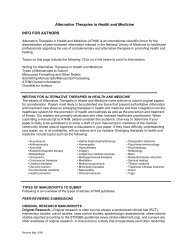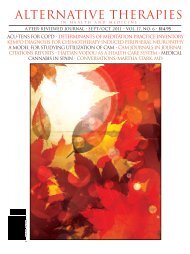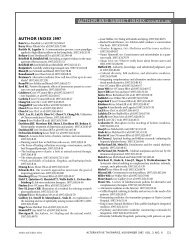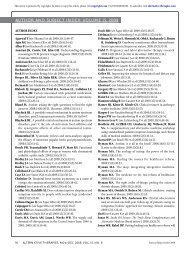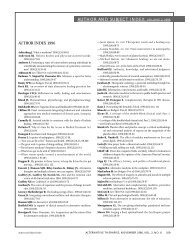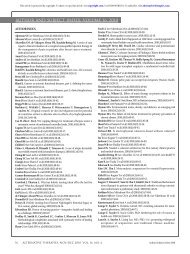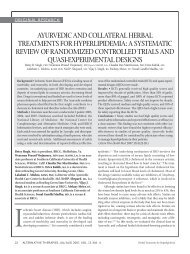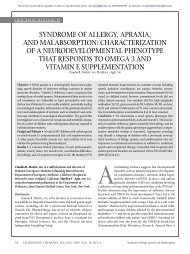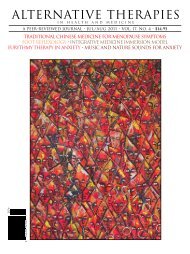Alternative Therapies In Health And Medicine
Alternative Therapies In Health And Medicine
Alternative Therapies In Health And Medicine
Create successful ePaper yourself
Turn your PDF publications into a flip-book with our unique Google optimized e-Paper software.
TABLE 2 Group Education Sessions Provided During<br />
the Support Phase<br />
1. A Healing Journey Through Cancer: <strong>In</strong>tegrative <strong>Medicine</strong><br />
Approaches for Prevention and Treatment<br />
2. Maximize Back, Joint, and Muscular <strong>Health</strong><br />
3. A Woman’s Midlife <strong>Health</strong> Journey: Embracing Perimenopause<br />
and Menopause<br />
4. When Working Out Hurts: <strong>Alternative</strong> Treatments for Pain<br />
Management and Relief for Sports and Exercise-related <strong>In</strong>juries<br />
5. <strong>In</strong>tegrative <strong>Medicine</strong> Strategies for Optimal Living: Approaches to<br />
the Prevention and Treatment of Cardiovascular Disease<br />
6. Give Yourself <strong>Health</strong>: The Power of Your Mind/Body Connection<br />
7. <strong>In</strong> Search of the Optimal Diet<br />
8. Emotional Wellness: How Emotions Affect Your <strong>Health</strong> and<br />
Well-being<br />
questionnaire (demographics, disease history, family history, and<br />
behavioral measures; Table 3). 29,30 The model provides estimates of<br />
relative risk (5-year absolute risk relative to a peer group matched<br />
for age and gender), modifiable risk (level of 5-year risk that can be<br />
altered by behavior), and absolute risk (probability of disease<br />
expression within 5 years). The KYN patient questionnaire was<br />
completed online within the 2 weeks preceding the health immersion<br />
(baseline) and during the 2 weeks before the follow-up appointment<br />
7 to 9 months later (endpoint). The biological measures<br />
included in the KYN profile were collected in a fasting state on the<br />
first day of the immersion and again at the follow-up appointment.<br />
Approximately 2 weeks after baseline and endpoint, participants<br />
received information on their 5-year disease risk.<br />
Biological Measures. Biological outcome measures included<br />
blood pressure (BP), resting pulse, height, weight, body composition,<br />
body mass index (BMI), waist circumference, fasting glucose,<br />
lipid profile, and high sensitivity C-reactive protein (CRP). BP was<br />
measured on the left arm, using a manual sphygmomanometer. 31,32<br />
Participants were directed to sit quietly for 5 minutes before the<br />
first measurement. The radial pulse was taken for 30 seconds after<br />
completing the BP, and a second BP and pulse were taken 2 minutes<br />
later. Height was measured twice consecutively. Duplicate<br />
measurements of pulse, blood pressure, and height were averaged.<br />
Body weight was taken on a Tanita Scale (TBF-310GF; Tanita<br />
Corporation, Arlington Heights, Illinois) with participants in light<br />
indoor clothing and without shoes; participants were asked to fast<br />
12 hours prior to measurements and void before weighing. Body<br />
mass index was calculated as weight in kg divided by height in<br />
meters squared. Waist circumference was measured in triplicate<br />
and averaged according to the method used by Canoy et al. 34 All<br />
blood samples were collected after participants had fasted for 12<br />
hours. Blood assays were carried out by the Clinical Laboratory<br />
Improvement Amendments–certified Duke University <strong>Health</strong><br />
System core laboratory.<br />
Self-reported Psychosocial Measures. Burns Brief Mood<br />
Survey (BMS). The BMS 35 includes three five-item subscales for<br />
assessment of depression, anxiety, and anger during the previous<br />
1-week period. The BMS has been shown to be valid and<br />
Table 3 Know Your Number Disease Rick Components*<br />
Risk Factor CHD Stroke Diabetes<br />
Age<br />
Gender<br />
Ethnicity<br />
Diagnosed with CHD<br />
Previous stroke<br />
Diagnosed with diabetes<br />
Diagnosed with LVH<br />
Family history of CHD<br />
Daily aspirin use<br />
Current HRT therapy<br />
BMI<br />
Systolic blood pressure<br />
Current smoker<br />
Past smoker<br />
Exercise level<br />
Total cholesterol<br />
HDL<br />
C-reactive protein<br />
Diagnosed with other CVD<br />
Diagnosed with atrial fibrillation<br />
Family history of stroke<br />
Current use of hypertension medication<br />
Previous diagnosis of gestational diabetes<br />
Years since gestational diabetes<br />
Family history of diabetes<br />
Waist measurement<br />
Fasting blood glucose<br />
Abbreviations: CHD, coronary heart disease; LVH, left-ventricular<br />
hypertrophy; HRT, hormone replacement therapy; BMI, body mass<br />
index; HDL, high-density lipoprotein; CVD, cardiovascular disease.<br />
*Diabetes indicates type 2 diabetes mellitus; darkened blocks<br />
reflect variables used to calculate specific disease risks. Table content<br />
provided by Biosignia.<br />
reliable. 35-37 <strong>In</strong> the present study, Cronbach’s α for anger, anxiety,<br />
and depression subscales were 0.82, 0.85, and 0.90, respectively.<br />
Relationship Satisfaction Scale (RSAT). The RSAT assesses the<br />
level of satisfaction or dissatisfaction felt by the participant in reference<br />
to their closest personal relationship; it was selected for the<br />
current study as an indicator of social support. This five-item scale<br />
demonstrates good convergent and discriminate validity. 35<br />
Responses were measured on a Likert scale with anchors of satisfied<br />
and dissatisfied. Cronbach’s α was 0.97 in the present study.<br />
Disease Risk Improves With <strong>In</strong>tegrative Immersion Model<br />
ALTERNATIVE THERAPIES, jul/aug 2011, VOL. 17, NO. 4 41



